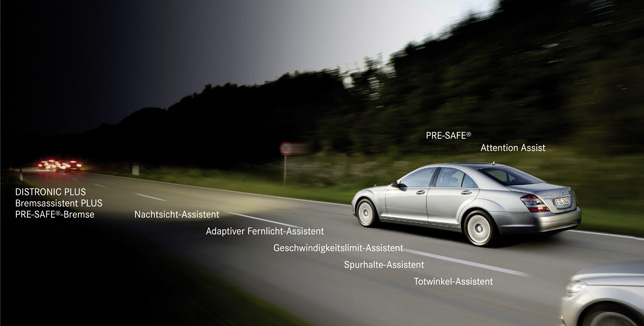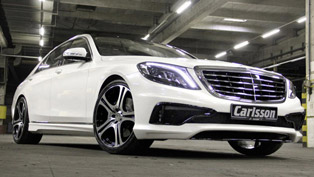In the new E-Class and S-Class from spring 2009
By introducing around a dozen new or modified systems, Mercedes-Benz is adding a new chapter to its long history of passenger- car safety. Following on from their successes achieved in the domain of occupant protection, the Mercedes experts will be focussing more than ever on avoiding traffic accidents and reducing accident severity, with the driver assistance systems being unveiled in the new E-Class and the model year 2009 S-Class from spring 2009 onwards set to play a crucial role. Mercedes-Benz is implementing a globally unique synergy of sophisticated safety technologies to give its cars extra "senses" and added intelligence. All of which makes Mercedes models part of the "thinking" process – cars that can see, sense and act autonomously. In addition to this, the Mercedes saloons show the way ahead when it comes to occupant protection and set new standards with their "electronic" crumple zones.
Like tried-and-trusted Mercedes inventions such as ABS, ESP®, Brake Assist and PRE-SAFE®, the new assistance systems have been adapted based on real-life accident findings. The aim behind their development was to prevent extremely frequent types of collision and collisions with serious consequences by focussing on the causes of accidents: distance to other vehicles, speed, drowsiness, darkness and lane departure.
To this end, Mercedes-Benz is for the first time using camerasalongside radar sensors. These long-range cameras monitor the area around the car and are able to interpret critical situations. By way of example, new camera-based assistance systems help the driver by keeping the car safely on track, detecting speed-limit signs, controlling the headlamps in line with the current driving situation and enhancing visibility in the dark.
 The new E-Class will be the world's first car to feature headlamps that adapt automatically in line with the current driving situation. Adaptive Highbeam Assistdetects oncoming vehicles or moving vehicles in front with their lights on and adjusts the headlamps continuously so as to always provide the best possible headlamp range – without dazzling other motorists. In this way, the low-beam range can be increased from its current level of 65 metres to up to 300 metres.
The new E-Class will be the world's first car to feature headlamps that adapt automatically in line with the current driving situation. Adaptive Highbeam Assistdetects oncoming vehicles or moving vehicles in front with their lights on and adjusts the headlamps continuously so as to always provide the best possible headlamp range – without dazzling other motorists. In this way, the low-beam range can be increased from its current level of 65 metres to up to 300 metres.
If the road ahead is clear, the system switches to high beam with a minimum of fuss. This Mercedes development is therefore fundamentally different to conventional systems of this type, since the latter merely switch between low beam and high beam.
Adaptive Highbeam Assist: the best possible light in any traffic situation
Tests show that motorists who use Adaptive Highbeam Assist are safer on the road in the dark because they see pedestrians, cyclists or obstacles on the road up to 150 metres earlier than is the case with conventional low beam. What's more, the system helps to relieve driver stress as there is no longer any need to repeatedly flick the stalk on the steering wheel. So the driver can concentrate more on actually driving the car. Once activated, Adaptive Highbeam Assist always provides the best possible headlamp range.
At the heart of the system is a camera, located on the inside of the windscreen, which sends new data every 40 milliseconds so that the range of the variable-control bi-xenon headlamps can be adjusted.
Mercedes-Benz has further developed its Night View Assist system, which illuminates a long stretch of the road ahead using invisible infrared light. The second generation of this system features a special pedestrian detection function: as soon as the system detects pedestrians ahead of the car, they are highlighted on the display.
 Lane Keeping Assist: warning if the car leaves its lane
Lane Keeping Assist: warning if the car leaves its lane
Another new assistance system developed by Mercedes can prevent accidents caused by the car leaving its lane. More than a third of all road users killed in Germanyare involved in this type of accident. This is why Mercedes-Benz has developed a "forward-looking" system for safe motoring called Lane Keeping Assist. Its camera monitors the line taken by the car and the driver's control inputs on a permanent basis, allowing the system to detect when the car leaves its lane unintentionally and if there is a risk of an accident. If this is the case, the system warns the driver in plenty of time, prompting them to counter-steer by making the steering wheel vibrate with a series of short, clearly discernable pulses.
Unlike conventional systems of this type, the Mercedes assistance system also assesses the driver's actions and, by doing so, can ascertain reliably whether the car has left its lane intentionally or unintentionally. There is therefore no warning if, for example, the driver accelerates before overtaking or joining a motorway, brakes heavily or steers into a bend.
If the system detects that the car is leaving its lane unintentionally, it activates an electric motor in the steering wheel, causing the steering wheel to vibrate. The timing of the warning depends on the width of the road and the type of lane markings. If the car crosses over a continuous line marking on the road, as opposed to a broken line, the system emits its warning earlier.
Speed Limit Assist: a camera with an eye for traffic signs
A further new assistance system reminds the driver of the current speed limit in force: the camera on the windscreen detects speed-limit signs as the car drives past them and then indicates the speed limit on the display in the speedometer. The driver therefore remains fully aware of the current speed limit, enabling them to adapt the car's speed accordingly. The display goes out as soon as the speed limit is lifted.
Thanks to the huge strides forward made in image-processing technology, Speed Limit Assist is able to work in real time, analysing the images within a fraction of a second – as the car drives past – and providing the driver with the required information instantaneously. Plus it makes no difference whether the speed-limit sign is at the side of the road or on a gantry above the road.
Furthermore, Speed Limit Assist evaluates the data provided by the navigation system's digital map, allowing it to check the plausibility of the camera image. By way of example, the last speed limit detected disappears from the display as soon as the navigation system detects that the car has entered a built-up area.
ATTENTION ASSIST: drowsiness detection system fitted as standard in the E-Class and S-Class
Thanks to a new technology, future Mercedes models will have a keen sense of their drivers' awareness. The aim is to detect driver drowsiness in plenty of time so as to warn them before they fall asleep momentarily. According to scientific studies, around a quarter of all serious motorway accidents are caused by driver drowsiness.
The new ATTENTION ASSIST system is equipped with highly sensitive sensors which monitor the driver's behaviour, the current driving situation and over 70 other parameters. By doing this, the system is able to detect when the driver's concentration starts to slip. This permanent form of monitoring is important for detecting the floating transition from awakeness to drowsiness and for warning the driver at an early stage. In addition to the speed, lateral acceleration and longitudinal acceleration, the system also detects use of the turn indicators and pedals as well as certain control inputs and external influences such as side winds or road unevenness, for example.
Observation of steering behaviour has proven to be extremely meaningful. Field tests carried out by the Mercedes engineers over a period of several years, involving over 550 participants to date, show that drowsy drivers make minor steering errors that are often corrected quickly and abruptly. These are detected by a highly sensitive steering wheel angle sensor. If ATTENTION ASSIST detects typical indicators of drowsiness based on these and other data, it warns the driver by emitting an audible signal and flashing up a message on the display: "ATTENTION ASSIST. Break!" ATTENTION ASSIST will be specified as standard for the new E-Class and the model year 2009 S-Class.
PRE-SAFE®: tensioning of the seat belts before an unavoidable accident
Further standard equipment Mercedes-Benz offers for these models includes the PRE-SAFE®anticipatory occupant protection system. Based on information received from sensors, it identifies situations that might turn into accidents and instinctively activates preventive occupant-protection measures, allowing the seat belts and airbags to deploy with maximum effect in the event of an impact. PRE‑SAFE® therefore bridges the gap between active safety and passive safety; it is networked to Brake Assist and the Electronic Stability Program (ESP®), whose sensors recognise potentially dangerous driving situations and then transmit this information to the electronic control units within milliseconds.
In another first, Mercedes-Benz will also be using the information provided by the short-range radar to trigger the seat belt tensioners at the very last moment before an unavoidable collision, thus greatly reducing the forces exerted on the driver and front passenger during the crash. Radar technology: sensor with medium-range detection capability and greater range
DISTRONIC PLUS and Brake Assist PLUS – Mercedes assistance systems based on sophisticated radar technology – are highly effective at helping to prevent accidents. Analysis of accident-research data has shown that this technology can prevent a fifth of all head-to-tail crashes in Germany on average. On motorways, the accident rate can be reduced by as much as 36 percent.
Mercedes-Benz has further enhanced the radar technology for the new E-Class and the model year 2009 S-Class. The newly developed long-range radar sensor will have a range of 200 metres instead of 150 metres as previously. In addition, the sensor now has medium-range detection capability, allowing monitoring of the area up to around 60 metres ahead of the car with a 60-degree beam width. This new technology enables even more accurate monitoring of the traffic situation in front of the car and even better detection of dynamic events such as a car in front swerving suddenly. The two wide-beam short-range radar sensors (80-degree beam width) with a range of around 30 metres are still employed.
PRE-SAFE® Brake: autonomous emergency braking as "electronic" crumple zone
As well as warning drivers in the new E-Class and the S-Class of an imminent head-to-tail crash, radar technology can also assist with emergency braking. The sensors are networked with Brake Assist PLUS, which automatically calculates the brake pressure required to prevent an imminent collision. This braking assistance, available as soon as the driver hits the brake pedal, allows controlled, targeted braking or – if necessary – emergency braking, depending on the car's speed and the distance to the vehicle in front.
If the driver fails to react to the warnings given by Brake Assist PLUS, the PRE-SAFE® Brake intervenes and brakes the car autonomously: around 1.6 seconds before the calculated impact point, the system initiates autonomous partial braking and decelerates the car with around 40 percent of the maximum braking power.
In the new E-Class and the model year 2009 S-Class, this safety system provides a further function: if the driver still fails to act after automatic partial braking, the PRE-SAFE® Brake activates the maximum braking power around 0.6 seconds before the now unavoidable impact and, as a consequence, can greatly reduce the severity of the accident. The system therefore acts like an "electronic crumple zone", offering the car occupants even greater protection.
Occupant protection: over 150 crash tests for the highest possible level of Mercedes safety
During the course of its development to date, the new E-Class has successfully come through over 150 high-speed crash tests and more than 17,000 realistic crash simulations, including around 40 different crash tests which the saloon had to pass in order to gain world-wide approval and nine extremely demanding, in-house impact tests, some of which go well beyond the statutory requirements.
The Sindelfingen-based engineers have continued to perfect the crumple-zone principle invented by Mercedes safety pioneer Béla Barényi. The front deformation zones of the latest Mercedes passengers cars work on several levels – making them even more effective as the impact forces are distributed over a wide area and can be made to bypass the passenger cell. Likewise the increased use of ultra-high-strength steel alloys helps the bodyshell to withstand high impact loads. These steel grades offer maximum strength whilst minimising weight. Around 72 percent of all the bodyshell panels for the new E-Class are made from sophisticated high-tech steel grades – a new record in passenger-car development.
With a total of seven airbags fitted as standard, not to mention seat-belt tensioners, belt force limiters and NECK-PRO crash-responsive head restraints, the new E‑Class will offer an even more extensive package of safety equipment than its predecessor. Self-adaptive belt-force limiters in the rear, which adapt automatically to suit the size of the rear passengers, will be introduced for the first time in autumn 2009.
Pedestrian protection: new E-Class with active bonnet fitted as standard
Mercedes-Benz is continuing its long-standing and very successful commitment to protecting those road users who are most at risk. Standard equipment for the new E-Class includes an active bonnet, which greatly reduces the risk of injury to pedestrians. In the event of an accident, a system of springs raises the rear section of the bonnet by 50 millimetres within milliseconds, thus enlarging the deformation zone. One special feature of this Mercedes system is its reversibility: drivers can reset the active bonnet themselves without having to visit a workshop.






